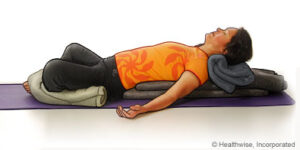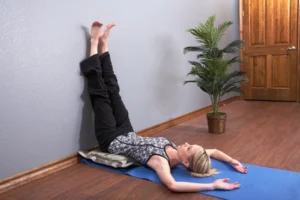Trouble sleeping? Try this.
Bedtime Yoga for Relaxation: A Gentle Way to Wind Down
Struggling to relax before bed? You’re not alone. In our busy lives, it's easy to carry stress and tension straight into sleep. But a short, simple bedtime yoga routine can help your body and mind shift into rest mode — setting you up for deeper, more peaceful sleep.
These gentle, supported poses are perfect for calming the nervous system at the end of the day. You don’t need to be a yogi or even particularly flexible. All you need is a few blankets, pillows, and a few minutes to yourself.
For extra comfort, try playing soft background music (I like Buddha’s Lounge or Zen Meditation Planet) while you practice.
6 Gentle Yoga Poses to Help You Unwind
Hold each of the following poses for several minutes, breathing slowly and allowing your body to relax more deeply with each exhale. Use rolled blankets or pillows to support your body fully.
-
Child’s Pose
-
Supported Bridge Pose
-
Reclining Bound Angle Pose
-
Legs Up the Wall
-
Supported Spinal Twist
-
Corpse Pose (Savasana)
Take your time moving between poses, and adjust props as needed so you feel completely supported.
Create a Soothing Bedtime Routine
A few simple rituals can make a big difference in signaling to your brain that it’s time to rest.
-
Wind Down
Wash up, slip into your coziest clothes, and dim the lights. Light a candle or turn on a soft lamp. -
Reflect and Release
Grab a notebook and write down three unique things you’re grateful for. This helps shift your mind out of stress and into appreciation. -
Do Your Bedtime Yoga Practice
Lay out your mat, grab your props, turn on some relaxing music, and move through your yoga poses. Focus on your breath and how your body feels in each pose. -
Center Yourself
Sit quietly with your eyes closed and practice a few minutes of Andrew Weil's 4-7-8 breathing or HeartMath’s Quick Coherence Technique to help regulate your nervous system. -
Prepare for Sleep
Spritz your pillow with lavender. Roll up your mat, blow out your candle, and get your room as dark and cool as possible. Cozy up in bed. -
Final Rest
Lie on your back with one hand on your heart and one on your belly. Let a gentle smile come to your face. Think about the good in your day, the healing rest ahead, and allow yourself to drift off.
Trouble Sleeping?
If you still have trouble falling asleep, try slow, mindful breathing or listen to binaural beats to entrain your brainwaves for rest. Some favorites:
What’s in Your Bedtime Toolkit?
I’d love to hear about your favorite bedtime rituals. Do you have a favorite yoga pose, playlist, or practice that helps you wind down? Leave a comment and share your tips — your insights might help someone else sleep better tonight.
About the Author
Sarah Murphy is a therapist who specializes in supporting people through serious illness and major life transitions. A longtime student of the Ageless Wisdom teachings, she is also committed to sharing the Great Invocation as a tool for healing and peace.
Self-Care for Chronic Illness: 3 Gentle Ways to Support Yourself
Living with chronic illness can make self-care feel complicated. When you're dealing with fatigue, pain, or ongoing symptoms, even small tasks can feel overwhelming. But real self-care isn’t about checking things off a wellness to-do list—it’s about meeting yourself where you are, with compassion, patience, and flexibility. Self-care for chronic illness can make a huge difference to your wellbeing.
Yet it often looks different than the version you see online. It may not be yoga classes or green smoothies (unless those feel good to you!). It may mean resting when you'd rather push through, or saying no when you wish you could say yes. It’s about tuning in to your body and honoring your needs—even when they change from day to day.
Here are three self-care practices that can gently support your well-being when you’re living with chronic illness:
1. Practice Self-Compassion (Especially on the Hard Days)
It’s easy to be hard on yourself when your body isn’t cooperating—when plans fall through, symptoms flare up, or you feel like you’re not doing “enough.” But chronic illness is not your fault. Offer yourself the same understanding you’d give to a loved one in your shoes. Self-compassion doesn’t make you weak—it makes you resilient. Try this: when you're feeling discouraged, ask yourself, What do I need right now? and What would kindness look like in this moment?
2. Honor Your Energy and Pace Yourself
Energy is a precious resource when you’re chronically ill. Self-care means respecting your limits, even when they don’t match what others can do. This might look like taking breaks before you’re exhausted, simplifying your schedule, or choosing rest without guilt. It’s okay to move slower. You are still living a full and valuable life, even if it looks different than it used to.
3. Nourish What Helps You Feel Whole
Even with illness, you are more than your diagnosis. Self-care includes nurturing the parts of you that bring meaning, joy, and connection. Maybe it’s listening to music, connecting with a friend who understands, spending time in nature, creating something, or simply remembering what you love. These moments don’t have to be big. Even small pleasures can help you feel more like you.
Self-care with chronic illness isn't about fixing yourself—it's about being gentle with yourself. It's about making space for both your challenges and your humanity. Some days will be harder than others, and that’s okay. You’re doing your best in a body that asks more from you than most.
And remember: your worth isn’t defined by how much you do. You are worthy of care, rest, and love—just as you are.
About the Author
Sarah Murphy is a therapist specializing in supporting people facing serious illness and major life transitions. She is also a longtime student of the Ageless Wisdom teachings and is dedicated to sharing the Great Invocation as a tool for personal and collective healing.
What is trauma-informed therapy and how can it help?
If you've experienced trauma—whether recently or long ago—you may carry wounds that aren’t always visible. These wounds can affect your relationships, your physical health, your ability to trust, and how you feel in your own body. What is trauma-informed therapy? It's a compassionate approach that recognizes how deeply trauma can impact every part of your life—and offers a path toward healing that feels safe and empowering.
What Does “Trauma-Informed” Mean?
Trauma-informed therapy is not a specific technique or method. Instead, it’s a way of practicing therapy that understands the wide-reaching effects of trauma and prioritizes emotional safety, choice, and trust in the healing process. A trauma-informed therapist recognizes that trauma can affect how you think, feel, react, and relate to others—and works with you in a way that honors your pace and autonomy.
This approach is based on five key principles:
-
Safety
-
Trustworthiness
-
Choice
-
Collaboration
-
Empowerment
Rather than focusing only on symptoms, trauma-informed therapy looks at the whole person. Oprah said it best, years ago—it's not about "what's wrong with you", but "what happened to you?"
How Trauma Can Show Up
Trauma doesn’t only stem from a single event like an accident or assault. It can also come from ongoing stressors such as childhood neglect, emotional abuse, discrimination, or medical trauma. You might not even realize something was traumatic until later in life.
Common signs of unresolved trauma include:
-
Anxiety or panic
-
Mood swings or depression
-
Trouble sleeping or concentrating
-
Feeling numb or disconnected
-
Relationship difficulties
-
Physical symptoms without clear medical cause
You may find yourself stuck in patterns you don’t fully understand—or reacting strongly to things that “shouldn’t” feel so upsetting. Trauma-informed therapy can help you make sense of these reactions and gently begin to heal them.
How Trauma-Informed Therapy Helps
At its core, trauma-informed therapy creates a safe, supportive environment where you don’t have to explain or justify your feelings. The therapist respects your boundaries and helps you move at a pace that feels right for you. You’ll learn grounding techniques, emotional regulation skills, and ways to reconnect with your body and your strengths.
Importantly, you won’t be pushed to relive traumatic memories before you’re ready. Instead, the process is centered around you—your comfort, your voice, your healing.
With time, trauma-informed therapy can help you:
-
Understand and reduce symptoms
-
Rebuild a sense of safety and trust
-
Improve relationships
-
Regain confidence and self-worth
-
Feel more connected and in control
You Deserve to Feel Safe and Whole
If you’ve been carrying the weight of trauma, know that healing is possible—and you don’t have to do it alone. Trauma-informed therapy meets you where you are and walks with you gently toward where you want to be.
Whether you’ve just begun to explore your past or have been in therapy before, this approach offers a supportive, empowering way forward—rooted in the belief that you are more than what happened to you. If you want to explore how trauma-informed therapy can work for you, contact me.
About the Author
Sarah Murphy is a therapist specializing in supporting people facing serious illness and major life transitions. She is also a longtime student of the Ageless Wisdom teachings and is dedicated to sharing the Great Invocation as a tool for personal and collective healing.
How Therapy Can Support Someone with a Chronic Illness
Learning that you have a chronic illness can turn your world upside down. Your identity may shift, your future plans may feel uncertain, and you may find yourself asking, How is this happening to me? Alongside the physical realities of illness, the emotional and psychological toll can be just as overwhelming. The good news is that therapy can support someone with a chronic illness by offering a compassionate space to process these changes, build coping strategies, and navigate the complexities of your health journey with more clarity and support.
Emotional Support
Chronic illness often brings up a wide range of difficult emotions—fear, anxiety, grief, frustration, even hopelessness. Therapy provides a safe, nonjudgmental space to explore and express these feelings. By understanding your emotional responses and learning to sit with them, you gain more control over how they impact your daily life. Rather than feeling overwhelmed, therapy can help you feel seen, supported, and more capable of managing what you’re facing.
Coping Strategies
When your health changes, your old ways of coping may no longer serve you. Therapy can introduce new tools and practices tailored to your current needs—whether that’s building daily routines, learning mindfulness techniques, or managing fatigue and stress. A therapist can also offer gentle accountability, helping you stick with what works and adapt when things shift.
Support with Decision-Making
A chronic illness diagnosis often comes with a flood of decisions—about treatments, medications, lifestyle changes, and more. The sheer number of choices can be overwhelming. Therapy gives you space to sort through your options, talk out your concerns, and tune into your personal values. With clarity and support, you can make decisions that feel aligned with who you are and what you need.
Strengthening Resilience
Your sense of resilience may feel shaken—but it’s not gone. In therapy, you can reconnect with your inner strength, develop a more compassionate mindset, and build the skills needed to weather the ups and downs of illness. It’s not about pretending things are okay—it’s about learning how to meet life as it is, with courage and self-kindness.
Improved Communication
Managing a chronic illness often means navigating complex conversations with doctors, loved ones, and sometimes even employers. Therapy can help you express your needs more clearly and confidently, set boundaries, and reduce misunderstandings. Strong communication can lighten your emotional load and ensure your voice is heard.
You Deserve Support—Starting Now
Chronic illness can make it easy to put your own needs last. But therapy reminds you that you matter, too. You don’t have to navigate this journey alone. With the right support, you can feel more empowered, grounded, and cared for—one step at a time. To learn more about how therapy can help you, contact me.
About the Author
Sarah Murphy is a therapist specializing in supporting people facing serious illness and major life transitions. She is also a longtime student of the Ageless Wisdom teachings and is dedicated to sharing the Great Invocation as a tool for personal and collective healing.
Mindfulness and Meditation for Cancer Patients
Easing Stress, Finding Peace
Facing cancer—whether during diagnosis, treatment, or recovery—can bring overwhelming stress, anxiety, and uncertainty. Many people are turning to mindfulness and meditation for cancer patients as a way to find calm, manage emotions, and reconnect with a sense of inner peace. These simple yet powerful practices can offer support for both the body and mind, helping patients navigate the cancer journey with greater clarity and compassion.
What Is Mindfulness?
Mindfulness is the practice of gently bringing your attention to the present moment. It means noticing your breath, your body, and your thoughts without judgment. You don’t have to “clear your mind” or feel a certain way—just noticing what is happening right now, as it is, is enough.
Meditation is one way to practice mindfulness. It can involve sitting quietly, focusing on the breath, doing a body scan, or repeating a calming phrase. Even a few minutes of meditation can help you feel more grounded.
Emotional Support During Cancer
Mindfulness and meditation can ease anxiety, depression, and fear—common emotional experiences for anyone living with cancer. When you’re waiting for results, going through treatment, or adjusting to life after cancer, it’s natural for the mind to race ahead or revisit painful memories.
Mindfulness helps bring your attention back to what’s happening right now. Instead of getting stuck in "what ifs" or “why me,” you learn to notice thoughts and emotions with more space and less reactivity. This can create a feeling of emotional relief—even if your circumstances haven’t changed.
In fact, research shows that mindfulness-based practices can significantly reduce distress in people undergoing cancer treatment, and even help with post-treatment adjustment.
Physical Benefits
Living with cancer often means coping with physical symptoms like fatigue, pain, or insomnia. Mindfulness and meditation don’t take these experiences away, but they can change how we relate to them. It’s not about having rose-colored glasses or never shedding a tear. It’s about being with however we are in the moment, with gentle curiosity and acceptance.
People who meditate experience physical changes. For example, many people report sleeping better when they practice mindfulness regularly—even just 10 minutes a day. The way we relate to physical sensations can change, too – body scan meditations can help people tune in to sensations with curiosity instead of fear. Breathing practices can reduce the intensity of pain and calm the nervous system.
Interestingly, studies show that these practices have an impact at the molecular level in our bodies.A 2014 study published in the journal Cancer found that cancer survivors who practiced meditation over a three-month period maintained the length of their telomeres—the protective caps at the ends of chromosomes that influence cellular aging—while those who did not meditate experienced telomere shortening and fraying.
A Gentle Way to Reconnect
Cancer can create a painful disconnect from your body and sense of identity. Mindfulness offers a way to gently come back into relationship with yourself, with no pressure or expectation. You can start small—maybe by noticing your breath for a few minutes in the morning, or sitting with a warm cup of tea and simply paying attention.
Many hospitals and cancer centers now offer mindfulness or meditation programs, and there are free apps and recordings designed specifically for people navigating illness, such as those from the Mindful Awareness Research Center or Insight Timer.
You Deserve Peace, Too
We aren’t talking about being Polly Positive all the time. We are talking about ways to treat yourself with more kindness. And that is something everyone can use a little more of.
Whether you’re in treatment, recovering, or living with uncertainty, you deserve moments of peace, connection, and presence. You will find that mindfulness and meditation won’t change your diagnosis, but it can change how you move through it—one breath, one moment, one small act of self-kindness at a time.
About the Author
Sarah Murphy is a therapist specializing in supporting people facing serious illness and major life transitions. She is also a longtime student of the Ageless Wisdom teachings and is dedicated to sharing the Great Invocation as a tool for personal and collective healing.
The Benefits of Mindfulness and Meditation
In today’s fast-paced world, we can easily get swept up in stress, distraction, and constant mental chatter. These contribute directly to depression and anxiety. Mindfulness and meditation offer powerful tools to bring us out of distress and back to the present moment—and to ourselves. Backed by both ancient wisdom and modern science, these practices can help us live with more calm, clarity, and compassion. The benefits of mindfulness and meditation impact our mental and emotional health as well as our physical wellbeing.
What Is Mindfulness?
Mindfulness is the practice of paying attention to the present moment. It means noticing our thoughts, feelings, and physical sensations as they arise, rather than reacting on autopilot. Mindfulness is not about “emptying the mind” or striving to feel a certain way. Instead, it invites us to be present to our moment-to-moment experiences, bringing gentle curiosity in place of striving or judgment.
Meditation is one way to cultivate mindfulness. It often involves sitting quietly and bringing focused attention to the breath, body, sounds, or even thoughts. There are many styles of meditation, from breath awareness to mantra sounding to loving-kindness. All of them can support greater mindfulness in everyday life.
The Psychological Benefits
Numerous studies have shown that mindfulness and meditation can reduce symptoms of anxiety, depression, and stress. By learning to observe thoughts and emotions without immediately reacting, people often find a greater sense of emotional regulation. One study even showed that brain regions changed in just eight weeks. Over time, practicing mindfulness helps us build resilience—the ability to bounce back from challenges.
Mindfulness can also improve focus and attention. In a world full of distractions, many of us struggle to stay present with one task or conversation. Research shows that regular meditation enhances cognitive performance and increases the ability to concentrate.
For individuals with trauma histories, mindfulness-based approaches can gently support healing by reconnecting with the body and staying grounded in the here and now. We should approach this with care, often with guidance from a trained therapist, but it can be a powerful part of the healing process.
The Physical and Lifestyle Benefits
The benefits of mindfulness and meditation don't stop with mental health—it can also support physical well-being. Research has found that mindfulness practices can lower blood pressure, improve sleep quality, and reduce inflammation in the body. Other studies show meditation can help improve immune function and lower levels of the stress hormone cortisol.
Practicing mindfulness can enhance everyday life. People often report feeling more present with their loved ones, more patient in stressful situations, and more in tune with their needs and boundaries. Even a few minutes of mindfulness each day can shift the way we relate to ourselves and the world.
Get Started
You don’t need hours of free time or a perfectly quiet room to start. Just taking ten minutes to breathe, notice your body, or pay attention to your surroundings can be a meaningful beginning. Apps like Insight Timer or Headspace can help with guided meditations, and the internet is filled with oodles of gilded meditations from experts like Tara Brach and Jack Kornfield (two of my favorites!).
Mindfulness and meditation are not quick fixes, but over time, they can transform how we live. As we learn to pause, breathe, and notice the present, we open the door to a calmer, more compassionate way of being.
About the Author
Sarah Murphy is a therapist specializing in supporting people facing serious illness and major life transitions. She is also a longtime student of the Ageless Wisdom teachings and is dedicated to sharing the Great Invocation as a tool for personal and collective healing.
What Self-Care Really Means (And 3 Ways to Improve Yours)
Self-care isn't just about bubble baths, massages, or getting your nails done—though those can be lovely! Real self-care means taking care of your whole self: your body, your mind, your emotions, and your spirit. It’s about creating a life where you can feel grounded, connected, and supported—even on the hard days.
At the heart of self-care is self-compassion. That means treating yourself with the same kindness and understanding that you would offer a friend. It means asking yourself:
-
Do I tend to be harder on myself than I am on others?
-
Can I give myself grace when I make a mistake or have a bad day?
-
Have I lost touch with the things that bring me joy or help me grow?
Self-care isn’t one-size-fits-all, but here are three foundational ways to improve yours:
1. Be Kind to Yourself
Most of us have an inner critic that's quick to point out flaws and mistakes. But self-care means being your own encourager, not your own bully. When you’re struggling, try asking: What would I say to someone I love in this moment? Then offer those same words to yourself. Self-forgiveness and self-kindness are powerful tools for healing and growth.
- 2. Make Time for What Matters
Life gets busy, and it’s easy to go on autopilot—moving from task to task without pausing. But self-care means making time for things that fill you up: creativity, movement, music, nature, connection, learning, rest. Think about what you loved doing before life got so busy. What small thing could you bring back today?
3. Support Your Body and Mind
Taking care of your physical health supports your emotional and mental well-being too. Eat foods that nourish you, drink enough water, and move your body in ways that feel good—not punishing. Add in a little mindfulness each day, even just a few minutes of breathing deeply, noticing your thoughts, or feeling your feet on the ground.
And remember your why. Why do you show up each day, even when it’s hard? What gives your life meaning? Self-care helps you stay connected to that deeper purpose and live from it.
Self-care isn't selfish or indulgent—it's essential. It helps you show up more fully for the people you love and the life you want to live. Start small. Be patient. And know that every step you take toward caring for yourself counts.
Create a self-soothing toolkit
Tools for a self-soothing toolkit
From time to time, we all need a little boost in self-soothing. It’s helpful to have a toolkit – things that we can use to calm our nervous system at any time. These techniques are also good components of a bedtime routine. Here are a few of my favorite tools in my self-soothing toolkit:
Quick Coherence Technique – video here. Breathe from the center of your chest; slow down your respiratory rate to about 5 seconds in, 5 seconds out. Once you have the rhythm, deliberately access good feelings by thinking of someone or something that inspires gratitude, compassion, or appreciation. Do this for 3-5 minutes.
Andrew Weil’s 4-7-8 breathing – video here. Breathe in for a count of 4, hold for a count of 7, exhale for a count of 8. Repeat.
Simple EFT – video here. Tap on the sides of your hands, thinking of your problem and affirming that you accept yourself. Then tap the top of your head, inside eyebrow corner, outside of eye, under eye, under nose, under lip, under collar bone, and under armpits. Repeat till you feel better.
Soothing Butterfly Hug – video here. Cross your hands over your chest and alternate tapping each side, rhythmically, like the wings of a butterfly. Do this for several minutes while breathing comfortably.
Simplified Self-Havening – video here. Place your hands on opposite shoulders and run them down your arms to your elbows, firmly but not harshly. Repeat.
Yoga moves for relaxation – especially great for bedtime.
Use rolled blankets and pillows for support! Hold each pose for a few minutes. For an extra-soothing session, play some soothing background music, like this from Buddha’s Lounge, or this from Zen Meditation Planet.
Child’s Pose
Supported Bridge Pose
Reclining Bound Angle Pose
Legs Up the Wall
Supported Spinal Twist
Corpse Pose/Savasana
Soothing bedtime routine
After washing up and getting into your comfy clothes, light a candle, pull out your notebook, and take a few minutes to reflect on your day. Write your gratitudes – three unique things you are grateful for right now. Keep your lighting as dim as feasible for this.
Then, dim the lights even more. Pull out your yoga mat, some rolled blankets and pillows, turn on some soothing music, and do a few soothing yoga postures.
Sit on your mat, or on some pillows on your mat, close your eyes, and do a few minutes of Quick Coherence Technique or 4-7-8 breathing (see above).
Spray your pillow with lavender. Roll up your mat, put your blankets and pillows back, blow out your candle. Make any final adjustments before going to bed.
Make sure your room is dark and cool, and that your bedding and bedclothes are not too warm.
You can lie on your back with one hand on your heart and one on your belly while you allow a soft smile to play on your face. Think gently about the goodness of your day, the sweet dreams you will have, and allow yourself to drift off to sleep.
If you have trouble sleeping, try entraining your brainwaves by breathing slowly or listening to some delta wave binaural beats, like this from Yellow Brick Cinema or this from Sleep Tube. I really love this from Jason Lewis Mind Amend, though it’s alpha-theta waves and meant to boost the immune system. 😊
What are your favorite bedtime routines? Your favorite items for a self-soothing toolkit? Leave me a comment and let me know!
Image sources: Child's Pose: Very Well Fit; Supported Bridge: Women's Health Network; Reclining Bound Angle: My Health Alberta; Legs Up the Wall: Peleton; Supported Spinal Twist: Yoga International; Savasana: Yoga Journal
Sarah Murphy, LPC, ACP-EFT, is a counselor in private practice and specializes in working with people who have serious illnesses. A student of the Ageless Wisdom, she is dedicated to sharing the Great Invocation.
Is There Any Research on Distant Healing?
Professor Chris Roe, Dr. Elizabeth Roxburgh and Ms. Charmaine Sonnex at the University of Northampton conducted two meta-analyses of research studies on non-contact healing published in the journal Explore. This study is not new but is worth a new look. It adds to the small but growing body of research on distant healing. It recently came to our attention through the Confederation of Healing Organizations.
The theory
Distant or “noncontact” healing is an ancient form of healing that is garnering new attention in nontraditional circles. Noncontact healing includes approaches like intercessory prayer and Reiki. Researchers wondered if noncontact healing can have a positive effect on the recipient’s wellbeing. They also wanted to account for possible placebo or expectancy effects.
The study setup
Researchers performed two meta-analyses of published studies on distant healing. The first group of healing subjects were human, while the second consisted of non-human organisms like plants and cell cultures. Including non-human subjects is useful as they are not subject to placebo or expectancy effects. Researchers included 57 human and 49 non-human target studies in the analyses. They conducted Pearson r correlation analysis to study the effects of these interventions.
Study results
Subjects that received healing experienced significant improvement in wellbeing relative to control subjects. The combined effect size was a small but highly significant r=.193.
The 57 human studies yielded a small but significant effect size (r=.203). Of these, the 27 studies that met higher quality thresholds had slightly stronger effects (r=.224).
The 49 non-human studies (cell clusters, plants, etc.) achieved slightly higher effects (r=.258). Of these, the 22 studies that had higher quality standards had a lower but still significant effect size (r=.115).
Conclusion
Results suggest that subjects in the active treatment condition exhibit a significant improvement in wellbeing relative to control subjects under circumstances that do not seem to be susceptible to placebo and expectancy effects.
Why research on distant healing matters
Many people believe in the power of intercessory prayer, Reiki, and other forms of distant healing. Some do not believe it possible to study subtle phenomena such as healing with scientific methods. Simultaneously many professionals and researchers remain skeptical about distant healing. These meta-analyses add scientific credibility to the efficacy of these increasingly popular techniques.
You can stay up to date with the research on energy psychology here or ask to be added to the research mailing list.
Authors:
Sarah Murphy, LPC, ACP-EFT, is a counselor in private practice and specializes in working with people who have serious illnesses. A student of the Ageless Wisdom, she is dedicated to sharing the Great Invocation.
John Freedom, CEHP, serves as chairman of ACEP’s research committee. He is the author of Heal Yourself with Emotional Freedom Technique.
New Study Casts Doubt on Serotonin Theory of Depression
For decades, many people in the public, clinicians, and the scientific community have accepted the "chemical imbalance" explanation of depression. However, a new study by review by Moncreiff et al (2022) challenges this long-held belief. Their comprehensive review found scant evidence linking low serotonin levels to depression. This finding has significant implications for understanding and treating this complex mental health condition and casts doubt on the serotonin theory of depression.
The theory:
The serotonin theory of depression proposes that low levels of the neurotransmitter serotonin cause depression symptoms. This theory has influenced public perception and treatment approaches for many years. However, the lack of robust scientific evidence supporting this theory has raised concerns among researchers.
The study setup:
Moncreiff and colleagues conducted a meticulous review of existing research on serotonin and depression. They analyzed data from 17 diverse studies, including systematic reviews, meta-analyses, and genetic studies.
Study results cast doubt on serotonin theory of depression:
- The review found no consistent evidence to support the link between low serotonin and depression.
- Studies examining serotonin metabolites, plasma serotonin levels, and receptor activity did not show a clear connection to depression.
- Interestingly, some evidence suggests that long-term antidepressant use might actually decrease serotonin levels.
- Genetic studies also failed to find a significant association between the serotonin transporter gene and depression.
Beyond the Headlines:
These findings challenge the oversimplification of depression as a solely "chemical imbalance". While further research is needed, this study highlights the importance of considering broader factors that contribute to depression, such as psychological, social, and environmental influences.
Moving Forward:
Understanding the limitations of the serotonin theory can pave the way for more holistic and individualized approaches to treating depression. This includes exploring a wider range of therapeutic options, including therapy, lifestyle modifications, and alternative treatment modalities.
If you or someone you know is struggling with depression, it's crucial to seek professional help. A mental health professional can provide personalized guidance and support to develop an effective treatment plan. You can find an ACEP-aligned clinician here.
Do you love research? Stay up to date with the research on energy psychology here or ask to be added to the research mailing list.
Author bio:
Sarah Murphy, LPC, ACP-EFT, is an ACEP board member and communications committee chair. She is a counselor in private practice and specializes in working with people who have serious illnesses. A student of the Ageless Wisdom, she is dedicated to sharing the Great Invocation.
















